10 of the Most Common Skin Conditions
Medically reviewed by Leigh Ann Anderson, PharmD.
1. Acne (Acne vulgaris)
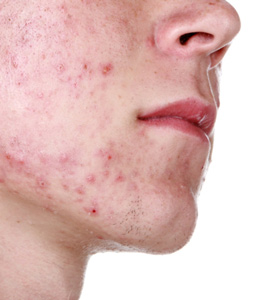
Acne, can be a source of anxiety for every teen. Plus, the incidence of acne is growing in adults, too.
Acne is caused by blocked hair follicles and oil (sebaceous) glands of the skin, often triggered by hormonal changes. The term acne refers to not only pimples on the face, but blackheads, cysts, and nodules as well. Some people get acne on other parts of their body too, such as the back and chest.
Acne treatment by a dermatologist is important because acne left unchecked can often lead to permanent scars and dark facial spots.
2. Atopic dermatitis (Eczema)
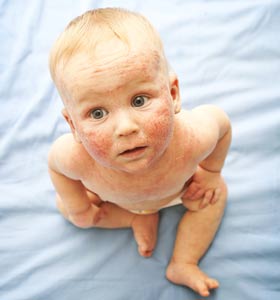
Atopic dermatitis is one of the most common forms of eczema seen in children. The exact cause of atopic dermatitis is not known, but researchers believe it may involve genetics, the environment, and/or the immune system.
Atopic dermatitis can appear on the face (especially in infants), hands, feet or in the creases and folds of the skin. Dry, scaly and itchy skin are the norm, and constant scratching may lead to a thickened area. While eczema often occurs in people with allergies, allergies do not cause eczema. Topical steroids are often used to lessen symptoms.
Dupixent
- In March 2017, the FDA cleared Regeneron’s Dupixent (dupilumab) injection to paptients with moderate-to-severe eczema who cannot use or have failed topical therapy.
- Clinical trials of Dupixent in over 2,100 adults with moderate-to-severe atopic dermatitis led to clear or almost clear skin as compared to placebo, with a reduction in itching, after 16 weeks of therapy.
- Dupixent is now also approved for use in pediatric patients 6 to 17 years of age and is available in a prefilled syringe for more convenient self-administration.
- Dupixent can be used with or without topical corticosteroids.
Eucrisa
- Eucrisa (crisaborole), from Pfizer, is a topical ointment first approved in Dec. 2016.
- It is classified as a phosphodiesterase 4 inhibitor and used for mild to moderate eczema in adults and children 3 months of age and older.
- It is applied a thin layer to the affected areas 2 times each day.
Other forms of eczema include contact dermatitis and seborrheic dermatitis.
3. Shingles (Herpes Zoster)
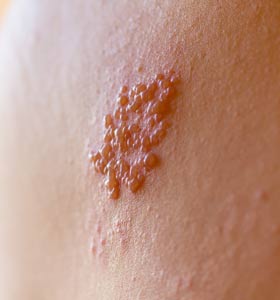
Shingles virus (herpes zoster) results in a red, blistered rash that may wrap around your torso or appear anywhere on your body. A fever, fatigue and headache may occur, too.
Two preventive shingles vaccines are approved in the United States:
- Zostavax (zoster vaccine live) is available as a subcutaneous injection to prevent shingles and is recommended for use in people 50 years or older.
-
Shingrix (herpes zoster subunit vaccine) is approved for the prevention of shingles (herpes zoster) in adults aged 50 years and older.
- Shingrix is a non-live (inactivated), recombinant subunit vaccine given intramuscularly in two doses, with the second dose given 2 to 6 months after the first.
- Shingrix is now the preferred vaccine over Zostavax due to a higher rate of effectiveness (>90% effective).
Shingles is caused by the same virus that causes chickenpox - the varicella-zoster virus. If you've had chickenpox, you're at risk for shingles as the chickenpox virus lies dormant (not active) in your nervous system for years.
Seniors and people with an impaired immune system are at highest risk. Shingles can be painful, but early treatment with antivirals like oral valacyclovir (Valtrex) can lessen symptoms.
4. Hives (Urticaria)
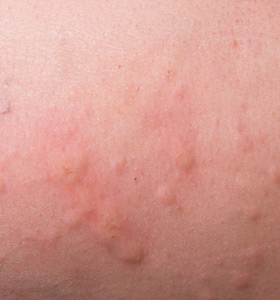
Hives are the familiar welts (raised, red, itchy areas) that can occur on the skin. Common causes of hives include medication, food, and bug bites or stings.
Seek urgent treatment if your hives cover a large area of your body, your throat or facial area is swelling, or they affect your breathing. Hives usually go away in 2 to 4 hours; however, in some people hives may persist for months or years; this is known as chronic urticaria.
Avoiding the trigger, whatever it may be, is the best tactic to prevent hives. When that is not possible, OTC antihistamines like loratadine (Claritin) or fexofenadine (Allegra) can be used to control itching.
A drug used to treat allergic asthma, omalizumab (Xolair injection), was approved in 2014 to treat chronic urticaria in those with no response to antihistamines.
In October 2019, Quzyttir (cetrizine injection) was approved by the FDA to treat acute urticaria (hives) in adults and children 6 months of age and older. Quzyttir is not recommended in children less than 6 years of age with impaired kidney or liver function.
5. Sunburn
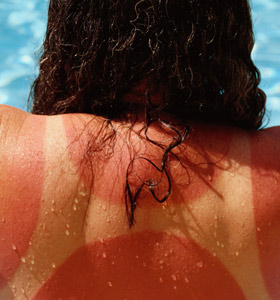
There's no doubt - it's easier to prevent a sunburn than to treat one.
Sunburns occur when there is too much exposure to ultraviolet (UV) light from the sun or sunlamps. The skin turns red, painful, hot to the touch, and may even peel away.
It's hard to know how much time is safe in the sun, though, even with sunscreen protection. Repeated sunburns, especially as a child, can boost the risk for skin cancer later in life. Usually sunscreen needs to be reapplied every 2 hours, but you may just need to stay out of the sun, too.
The first step in treating a sunburn is to seek shade, get inside if possible, and cool the skin down.
- Take a cool bath or shower with a mild soap.
- Drink plenty of fluids and moisturize the skin with a light, oil-free moisturizer or aloe vera while the skin is still damp.
- In some cases, an OTC topical product with lidocaine might be needed.
- Taking an NSAID, such as ibuprofen, can help with any discomfort or swelling.
See a doctor if you have a fever, chills or severe blistering over a large portion of your body. Don't scratch or pop any blisters - this could lead to infection.
6. Contact Dermatitis
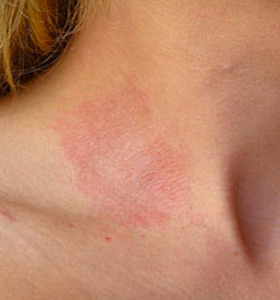
Most of us have had contact dermatitis - when we touch something that evolves into a skin reaction.
- Contact dermatitis is a type of eczema, and may come from plants (poison ivy, sumac, oak), jewelry, latex gloves, and irritants like bleach or soaps.
- To prevent contact dermatitis, avoid the object when possible.
- To control symptoms, antihistamines, oral or topical steroids, and colloidal oatmeal baths are often helpful.
If your doctor suspects you have contact dermatitis, and the cause is unknown, they may suggest patch testing. In patch testing, allergic substances are applied to your skin. In a few days, your doctor will check for a reaction.
7. Diaper Rash

Anyone who has a child knows about the common problem of diaper rash.
- A wet or soiled diaper left on too long can lead to red bumps and rash in the diaper area, the buttocks, genitals, and skin folds.
- Urine and stool can break down skin, and chemicals in a disposable diaper can dissolve out and irritate the skin.
- Candida (yeast) or bacteria can also take advantage of the inflamed, broken, skin and complicate the rash.
To help prevent diaper rash, change diapers as needed to keep the area dry and expose the baby's bottom to fresh air when possible.
You can use an ointment like Desitin (zinc oxide topical) to form a protective barrier on the baby's bottom. If the rash still persists after 2 to 3 days, consult with your pediatrician.
8. Rosacea
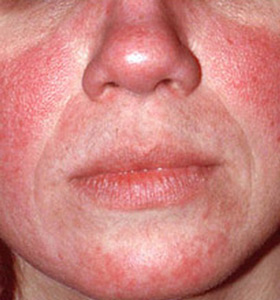
Rosacea is a chronic swelling of the face, with redness, prominent blood vessels, and pimples.
Rosacea is most common in women over 30, but men can be affected too. Problems with the immune system, vein problems and/or environmental issues can cause the condition.
9. Athlete's Foot (Tinea Pedis)
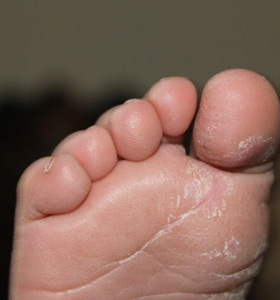
It's an unfortunate fact, but your feet are prone to fungal infections. Athlete’s foot can lead to extreme itching, redness, and cracked skin on the feet and in between the toes. A type of fungi called dermatophytes are commonly found in warm, moist areas like pool decks, shower stalls, and locker rooms.
Luckily, over-the-counter, topical antifungal treatments are readily available, such as:
- Lotrimin AF (clotrimazole)
- Lamisil AT (terbinafine)
- Micatin (miconazole)
It can take weeks for the infection to clear; check with your doctor if symptoms do not improve as you may need a prescription strength product.
You can help prevent athlete’s foot by keeping your feet clean and dry, changing wet socks and shoes, and wearing sandals in public pool or shower areas.
If fungus creeps under your toe nails, which can appear as a white, yellow or brown color with crumbly texture to your nail, be sure to see a podiatrist as more intensive treatment may be needed.
10. Basal Cell Carcinoma
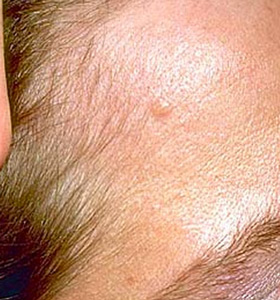
Basal cell carcinoma (BCC) is the most common type of skin cancer. BCC grows in the upper basal cells of your skin but rarely spreads and is curable. You may be prone to BCCs if you spend lots of time in the sun or use a tanning bed frequently.
Growths commonly occur on the head, ears, nose, and neck. They can look shiny, red and scaly, or like an open sore.
Article from Drugs.com

